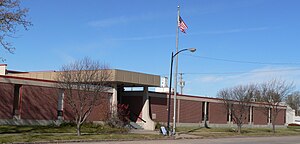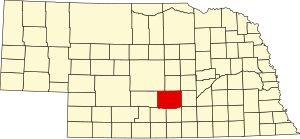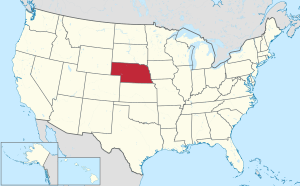Buffalo County is a county located in the U.S. state of Nebraska in the Midwestern United States. As of the 2020 United States Census, the population was 50,084,[1] making it Nebraska's fifth-most populous county. Its county seat is Kearney.[2] The county was created in 1855[3] and was organized in 1870.[4][5] It was named after the once-prevalent bison herds of the Great Plains.[6]
Buffalo County | |
|---|---|
 Buffalo County Courthouse in Kearney | |
 Location within the U.S. state of Nebraska | |
 Nebraska's location within the U.S. | |
| Coordinates: 40°52′N 99°04′W / 40.86°N 99.07°W | |
| Country | |
| State | |
| Founded | 1855 (authorized) 1870 (organized) |
| Named for | American bison |
| Seat | Kearney |
| Largest city | Kearney |
| Area | |
• Total | 975 sq mi (2,530 km2) |
| • Land | 968 sq mi (2,510 km2) |
| • Water | 7.3 sq mi (19 km2) 0.7% |
| Population (2020) | |
• Total | 50,084 |
| • Density | 51/sq mi (20/km2) |
| Time zone | UTC−6 (Central) |
| • Summer (DST) | UTC−5 (CDT) |
| Congressional district | 3rd |
| Website | www |
Buffalo County is part of the Kearney Micropolitan Statistical Area.
In the Nebraska license plate system, Buffalo County is represented by the prefix 9; when the license plate system was established in 1922, the county ranked ninth in number of registered vehicles.
History
editThe Union Pacific Railroad came to the area in 1866;[7] with additional settlers, the need to establish government was realized. Patrick Walsh, Martin Slattery, and a Sergeant Cody petitioned the governor to organize Buffalo County in 1869.[7] Wood River Centre (Shelton) was selected through election as county seat. Within a year, the seat was moved to Gibbon.[8] In 1874, voters selected Kearney as the seat.[9]
During the late 19th century and early 20th century, the Watson Ranch, existed in the county. The 8,000 acre ranch extended from the Platte River Valley on the south, to Nebraska's rolling hills on the north, to a point five miles west of downtown Kearney.[10][11]
Geography
editAccording to the US Census Bureau, the county has an area of 975 square miles (2,530 km2), of which 968 square miles (2,510 km2) is land and 7.3 square miles (19 km2) (0.7%) is water.[12]
Major highways
editTransit
editProtected area
editAdjacent counties
edit- Hall County – east
- Adams County – southeast
- Kearney County – south
- Phelps County – southwest
- Dawson County – west
- Custer County – northwest
- Sherman County –north
- Howard County – northeast
Demographics
edit| Census | Pop. | Note | %± |
|---|---|---|---|
| 1860 | 114 | — | |
| 1870 | 193 | 69.3% | |
| 1880 | 7,531 | 3,802.1% | |
| 1890 | 22,162 | 194.3% | |
| 1900 | 20,254 | −8.6% | |
| 1910 | 21,907 | 8.2% | |
| 1920 | 23,787 | 8.6% | |
| 1930 | 24,338 | 2.3% | |
| 1940 | 23,655 | −2.8% | |
| 1950 | 25,134 | 6.3% | |
| 1960 | 26,236 | 4.4% | |
| 1970 | 31,222 | 19.0% | |
| 1980 | 34,797 | 11.5% | |
| 1990 | 37,447 | 7.6% | |
| 2000 | 42,259 | 12.9% | |
| 2010 | 46,102 | 9.1% | |
| 2020 | 50,084 | 8.6% | |
| 2023 (est.) | 50,697 | 1.2% | |
| US Decennial Census[13] 1790-1960[14] 1900-1990[15] 1990-2000[16] 2010[17] | |||
2020 Census
editAs of the 2020 United States Census,[18] there were 50,084 people in the county. The population density was 51 inhabitants per square mile (20/km2) . The racial makeup of the county was 85.5% White, 1.3% Black or African American, 0.8% Native American, 1.5% Asian, 0.2% Pacific Islander, and 1.7% from two or more races. 10.1% of the population were Hispanic or Latino of any race
2000 Census
editAs of the 2000 United States Census,[18] there were 42,259 people, 15,930 households, and 10,227 families in the county. The population density was 44 inhabitants per square mile (17/km2). There were 16,830 housing units at an average density of 17 units per square mile (6.6/km2). The racial makeup of the county was 95.18% White, 0.55% Black or African American, 0.33% Native American, 0.68% Asian, 0.03% Pacific Islander, 2.20% from other races, and 1.03% from two or more races. 4.66% of the population were Hispanic or Latino of any race. 42.5% were of German, 8.1% Irish, 7.8% English, 6.8% American and 5.3% Swedish ancestry.
There were 15,930 households, out of which 32.70% had children under the age of 18 living with them, 52.90% were married couples living together, 8.30% had a female householder with no husband present, and 35.80% were non-families. 26.10% of all households were made up of individuals, and 9.60% had someone living alone who was 65 years of age or older. The average household size was 2.48 and the average family size was 3.02.
The county population contained 25.00% under the age of 18, 17.80% from 18 to 24, 26.60% from 25 to 44, 19.00% from 45 to 64, and 11.50% who were 65 years of age or older. The median age was 30 years. For every 100 females, there were 96.00 males. For every 100 females age 18 and over, there were 92.40 males.
The median income for a household in the county was $36,782, and the median income for a family was $46,247. Males had a median income of $30,182 versus $21,977 for females. The per capita income for the county was $17,510. About 6.30% of families and 11.20% of the population were below the poverty line, including 10.50% of those under age 18 and 8.50% of those age 65 or over.
Communities
editCities
editVillages
editCensus-designated places
editUnincorporated communities
editTownships
editPolitics
editBuffalo County voters have been strongly Republican for decades. Only seven Democratic Party presidential candidates have won the county from 1880 to the present day, the most recent of which being Lyndon B. Johnson in 1964.
| Year | Republican | Democratic | Third party(ies) | |||
|---|---|---|---|---|---|---|
| No. | % | No. | % | No. | % | |
| 2024 | 17,064 | 71.47% | 6,386 | 26.75% | 427 | 1.79% |
| 2020 | 16,640 | 70.18% | 6,350 | 26.78% | 721 | 3.04% |
| 2016 | 14,569 | 68.95% | 4,763 | 22.54% | 1,797 | 8.50% |
| 2012 | 13,570 | 69.76% | 5,365 | 27.58% | 518 | 2.66% |
| 2008 | 13,097 | 67.88% | 5,867 | 30.41% | 329 | 1.71% |
| 2004 | 14,222 | 76.43% | 4,100 | 22.03% | 286 | 1.54% |
| 2000 | 11,931 | 72.48% | 3,927 | 23.86% | 603 | 3.66% |
| 1996 | 10,004 | 63.09% | 4,277 | 26.97% | 1,575 | 9.93% |
| 1992 | 9,726 | 55.11% | 3,747 | 21.23% | 4,176 | 23.66% |
| 1988 | 9,981 | 67.31% | 4,702 | 31.71% | 145 | 0.98% |
| 1984 | 11,365 | 78.11% | 3,086 | 21.21% | 99 | 0.68% |
| 1980 | 9,769 | 68.59% | 3,167 | 22.24% | 1,307 | 9.18% |
| 1976 | 8,095 | 63.36% | 4,308 | 33.72% | 374 | 2.93% |
| 1972 | 8,587 | 74.19% | 2,988 | 25.81% | 0 | 0.00% |
| 1968 | 6,786 | 65.29% | 2,875 | 27.66% | 733 | 7.05% |
| 1964 | 5,425 | 49.95% | 5,436 | 50.05% | 0 | 0.00% |
| 1960 | 7,595 | 66.12% | 3,891 | 33.88% | 0 | 0.00% |
| 1956 | 7,342 | 70.31% | 3,100 | 29.69% | 0 | 0.00% |
| 1952 | 8,467 | 77.20% | 2,501 | 22.80% | 0 | 0.00% |
| 1948 | 4,862 | 56.68% | 3,716 | 43.32% | 0 | 0.00% |
| 1944 | 6,073 | 61.19% | 3,852 | 38.81% | 0 | 0.00% |
| 1940 | 6,387 | 61.14% | 4,060 | 38.86% | 0 | 0.00% |
| 1936 | 4,595 | 41.88% | 6,002 | 54.70% | 375 | 3.42% |
| 1932 | 3,773 | 38.02% | 5,872 | 59.18% | 278 | 2.80% |
| 1928 | 7,460 | 72.22% | 2,801 | 27.12% | 68 | 0.66% |
| 1924 | 4,746 | 54.11% | 2,337 | 26.64% | 1,688 | 19.25% |
| 1920 | 4,954 | 65.56% | 2,258 | 29.88% | 345 | 4.57% |
| 1916 | 2,216 | 41.79% | 2,877 | 54.25% | 210 | 3.96% |
| 1912 | 1,081 | 22.93% | 2,061 | 43.72% | 1,572 | 33.35% |
| 1908 | 2,526 | 48.60% | 2,520 | 48.49% | 151 | 2.91% |
| 1904 | 2,554 | 62.07% | 731 | 17.76% | 830 | 20.17% |
| 1900 | 1,916 | 46.45% | 2,056 | 49.84% | 153 | 3.71% |
See also
editReferences
edit- ^ "Buffalo County, Nebraska". United States Census Bureau. Retrieved June 16, 2023.
- ^ "Find a County". National Association of Counties. Archived from the original on May 31, 2011. Retrieved June 7, 2011.
- ^ (March 10, 2009) Buffalo County says 1855 was the date, Kearney Hub, Retrieved November 10, 2010
- ^ Andreas, A. T. (1882). "Andreas' History of the State of Nebraska". The Kansas Collection. Archived from the original on April 14, 2003. Retrieved December 13, 2014.
- ^ "Buffalo County Nebraska Historic Buildings Survey" (PDF). Nebraska State Historical Society. August 1, 1993. Archived from the original on November 16, 2006. Retrieved December 13, 2014.
- ^ Fitzpatrick, Lillian L. (1960). Nebraska Place-Names. University of Nebraska Press. p. 24. ISBN 0803250606.
- ^ a b Bassett, Samuel Clay (1916). Buffalo County, Nebraska, and its people: a record of settlement, organization, progress and achievement, Vol. 1. Chicago: S. J. Clarke Pub. Co. pp. 145–161. OCLC 3358457.
- ^ Duncan, Douglas. "Shelton - Buffalo County". Virtual Nebraska. Consortium for the Application of Space Data to Education (CASDE). Retrieved November 9, 2012.
- ^ Bowman, J. R. (1882). Shearer, Frederick E. (ed.). The Pacific tourist. J.R. Bowman's illustrated transcontinental guide of travel from the Atlantic to the Pacific Ocean. New York: J.R. Bowman. p. 33. OCLC 752667534. Retrieved May 13, 2018.
- ^ Holmgren, Philip S. (October 1979). "THE WATSON RANCH - Part I". Buffalo County Historical Society. Retrieved April 20, 2020.
- ^ "Watson, H. D., and the Watson Ranch". History Nebraska. Retrieved April 20, 2020.
- ^ "2010 Census Gazetteer Files". US Census Bureau. August 22, 2012. Archived from the original on November 13, 2013. Retrieved December 6, 2014.
- ^ "US Decennial Census". US Census Bureau. Retrieved December 6, 2014.
- ^ "Historical Census Browser". University of Virginia Library. Retrieved December 6, 2014.
- ^ "Population of Counties by Decennial Census: 1900 to 1990". US Census Bureau. Retrieved December 6, 2014.
- ^ "Census 2000 PHC-T-4. Ranking Tables for Counties: 1990 and 2000" (PDF). US Census Bureau. Archived (PDF) from the original on March 27, 2010. Retrieved December 6, 2014.
- ^ "State & County QuickFacts". US Census Bureau. Archived from the original on June 7, 2011. Retrieved September 17, 2013.
- ^ a b "U.S. Census website". US Census Bureau. Retrieved January 31, 2008.
- ^ Election Results
External links
edit- . The American Cyclopædia. 1879.